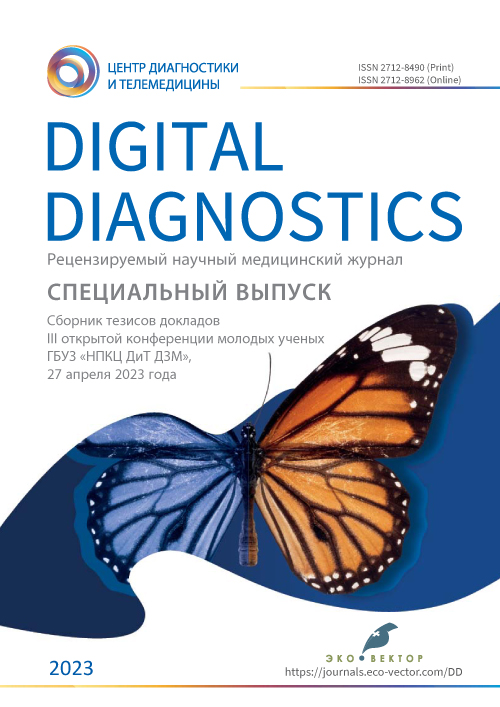Intralobar pulmonary sequestration with a rare source of arterial supply
- Authors: Vinokurov A.S.1,2,3,4, Smirnova A.D.2, Belenkaya O.I.1,2, Yudin A.L.1
-
Affiliations:
- N.I. Pirogov Russian National Research Medical University
- V.P. Demikhov City Hospital
- Moscow Multidisciplinary Clinical Center “Kommunarka”
- Moscow Clinical Center of Infection Diseases “Voronovskoe”
- Issue: Vol 4, No 1S (2023)
- Pages: 119-121
- Section: Conference proceedings
- Submitted: 18.05.2023
- Accepted: 18.05.2023
- Published: 26.06.2023
- URL: https://jdigitaldiagnostics.com/DD/article/view/430365
- DOI: https://doi.org/10.17816/DD430365
- ID: 430365
Cite item
Full Text
Abstract
BACKGROUND: Pulmonary sequestration is one of the most common malformations of the lungs in clinical practice. However, difficulties are possible in the interpretation of the radiological data, which leads to a violation of the examination technique in such patients and, accordingly, to the lack of success of the therapy and proper routing.
AIM: To demonstrate the clinical case of a patient with intralobar pulmonary sequestration, describing the characteristic radiographic picture, and suggesting research methodology for the identified features of the aberrant vessel.
METHODS: Clinical and radiological data of a 27-year-old patient with acute respiratory symptoms and suspected abscessed pneumonia based on X-ray and computed tomography (CT) findings were presented. Due to the absence of clinical and radiological dynamics, atypical CT semiotics of “abscesses”, CT angiography of the thoracic aorta was performed after intravenous contrast enhancement with 80 ml of iodine-containing preparation (350 mg/mL).
RESULTS: A pulmonary tissue thickening was revealed in the lower left lobe with lumpy clear contours, which consisted of a system of cystic cavities with contents, particularly well differentiated after contrast enhancement. On the native study, an additional vascular structure following from the subdiaphragmatic space was traced paravertebrally, which was the reason for extending the CT angiography scanning area to the epigastric region of the abdomen. A large-caliber arterial vessel was detected, which departed as a branch from the celiac trunk and passed to the above-described thickening of the pulmonary tissue. The combination of these signs is typical for intrapulmonary sequestration.
CONCLUSIONS: The correct interpretation of the identified changes allowed the patient to be routed to a hospital with a thoracic surgery department, since the sequestration must be removed in the vast majority of cases to prevent recurrent inflammatory episodes. Extension of the scanning area below the diaphragm may be useful, since part of the sequesters is supplied with blood from the abdominal aorta and its visceral branches. This will prevent the need for repeat CT angiography, and information about the source of the blood supply is extremely important for surgeons.
Full Text
BACKGROUND: Pulmonary sequestration is one of the most common malformations of the lungs in clinical practice. However, difficulties are possible in the interpretation of the radiological data, which leads to a violation of the examination technique in such patients and, accordingly, to the lack of success of the therapy and proper routing.
AIM: To demonstrate the clinical case of a patient with intralobar pulmonary sequestration, describing the characteristic radiographic picture, and suggesting research methodology for the identified features of the aberrant vessel.
METHODS: Clinical and radiological data of a 27-year-old patient with acute respiratory symptoms and suspected abscessed pneumonia based on X-ray and computed tomography (CT) findings were presented. Due to the absence of clinical and radiological dynamics, atypical CT semiotics of “abscesses”, CT angiography of the thoracic aorta was performed after intravenous contrast enhancement with 80 ml of iodine-containing preparation (350 mg/mL).
RESULTS: A pulmonary tissue thickening was revealed in the lower left lobe with lumpy clear contours, which consisted of a system of cystic cavities with contents, particularly well differentiated after contrast enhancement. On the native study, an additional vascular structure following from the subdiaphragmatic space was traced paravertebrally, which was the reason for extending the CT angiography scanning area to the epigastric region of the abdomen. A large-caliber arterial vessel was detected, which departed as a branch from the celiac trunk and passed to the above-described thickening of the pulmonary tissue. The combination of these signs is typical for intrapulmonary sequestration.
CONCLUSIONS: The correct interpretation of the identified changes allowed the patient to be routed to a hospital with a thoracic surgery department, since the sequestration must be removed in the vast majority of cases to prevent recurrent inflammatory episodes. Extension of the scanning area below the diaphragm may be useful, since part of the sequesters is supplied with blood from the abdominal aorta and its visceral branches. This will prevent the need for repeat CT angiography, and information about the source of the blood supply is extremely important for surgeons.
About the authors
Anton S. Vinokurov
N.I. Pirogov Russian National Research Medical University; V.P. Demikhov City Hospital; Moscow Multidisciplinary Clinical Center “Kommunarka”; Moscow Clinical Center of Infection Diseases “Voronovskoe”
Author for correspondence.
Email: antonvin.foto@gmail.com
ORCID iD: 0000-0002-0745-3438
Russian Federation, Moscow; Moscow; Moscow; Moscow
Alexandra D. Smirnova
V.P. Demikhov City Hospital
Email: alexa199503@yandex.ru
Russian Federation, Moscow
Olga I. Belenkaya
N.I. Pirogov Russian National Research Medical University; V.P. Demikhov City Hospital
Email: olga-belenkaya@mail.ru
ORCID iD: 0000-0003-1121-8040
Russian Federation, Moscow; Moscow
Andrey L. Yudin
N.I. Pirogov Russian National Research Medical University
Email: prof_yudin@mail.ru
ORCID iD: 0000-0002-0310-0889
Russian Federation, Moscow
References
Supplementary files















